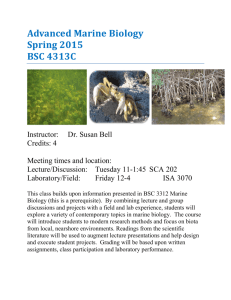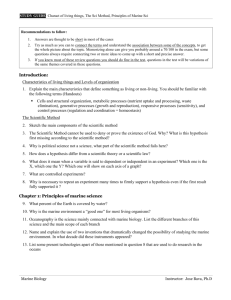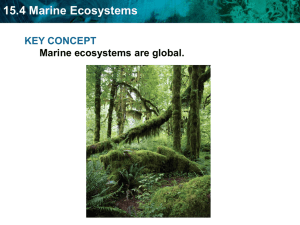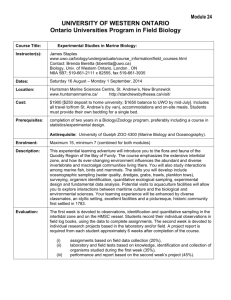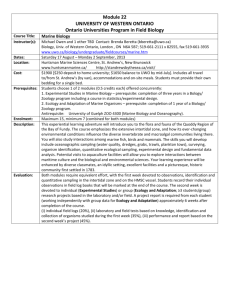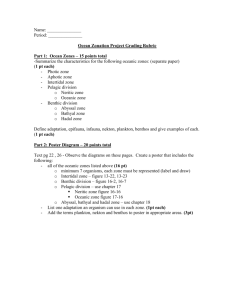Introduction to Marine Biology
advertisement
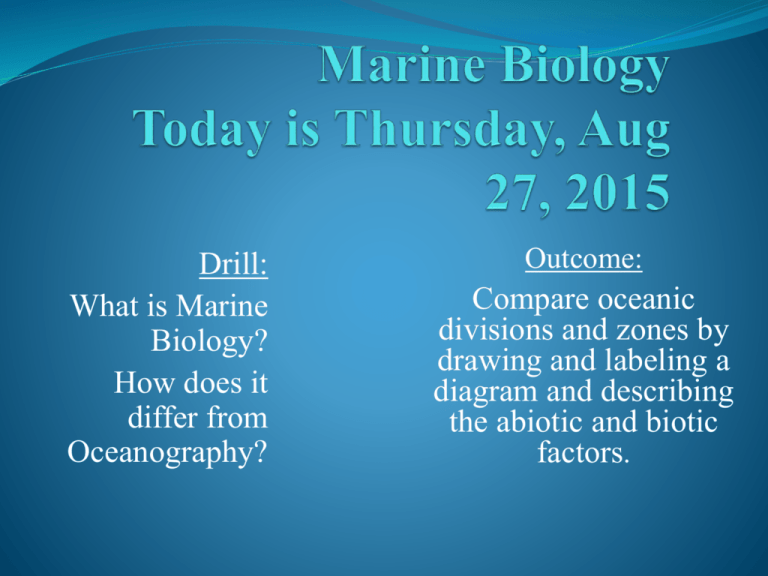
Drill: What is Marine Biology? How does it differ from Oceanography? Outcome: Compare oceanic divisions and zones by drawing and labeling a diagram and describing the abiotic and biotic factors. What is Marine Biology? How does it differ from Oceanography? Marine biology is the study of living organisms and how they interact in their environment Coral reefs and clown fish Epidemic affecting Sea Stars Oceanography is the study of oceans and their phenomena. Trenches Hurricane patterns Agenda Discuss the imp of Marine Biology. - How can it affect you? Define the different zones of the ocean. Draw oceanic divisions and zones. Catalog which organisms live in each zone. Vocabulary we will be looking at: - Marine Biology Biotic Abiotic Photic Disphotic Aphotic Pelagic Zone Neritic Zone Supralittoral Littoral Sublittoral - Oceanic Zone Epipelagic (Epi) Mesopelagic (Meso) Bathypelagic (Bathyal) Abyssalpelagic (Abyssal) Hadalpelagic (Hadal) What is Marine Biology? What can you do with a career in Marine Biology? What is Marine Biology? What can you do with a career in Marine Biology? What is Marine Biology? What can you do with a career in Marine Biology? But… Before you can start diving with killer whales, dolphins, and sharks you must know a little about their world! Everything we discuss in this class and prepare you for a jump start to a career in Marine Biology!! Stop me at ANY time if you have questions, comments, or concerns! Marine Scientists Marine scientists classify marine environments into many different regions based on physical characteristics. The ocean is classified into different zones or regions based on abiotic factors (light, depth, temperature, density, latitude, and distance) Photic Zone versus Aphotic Zone Photic Zone – is the depth to which light penetrates to support photosynthetic life Ex. Epipelagic Zone and the Neritic Zone Disphotic Zone – is the depth to which light penetrates but it will not support photosynthetic life Ex. Mesopelagic Zone Aphotic Zone – this is the layer of water light cannot penetrate, chemosynthesis Ex. Bathypelagic, Abyssopelagic, Hadalpelagic Location The Pelagic Zone is the water column portion. 1) Neritic zone – is the water located nearest the coast (coastal zone) between the low tide mark to the edge of the continental shelf. 2) Oceanic zone – is the open water area beyond the neritic zone. The oceanic zone is further divided into five separate regions. Pelagic Zone The Neritic Zone There are three zones located near the Neritic Zone: Supralittoral Zone – splash zone (This is NOT a part of the Neritic Zone) Littoral Zone – this is the intertidal zone. It’s the area between high tide and low tide. (This is part of the Neritic Zone.) Sublittoral Zone – this is area below the low water mark and the edge of the continental shelf. (This is NOT part of the Neritic Zone.) Neritic Zone Oceanic Zones Regions • The Oceanic Zone is further divided into five vertical regions: 1) Epipelagic zone – top layer sun light penetrates (0-200m) 2) Mesopleagic zone – sunlight reaches, but not strong enough to support photosynthetic life (200-1000m) 3) Bathypelagic zone – no sunlight/photosynthesis (1000-4000m) 4) Abyssalpelagic zone – no sunlight/photosynthesis (4000-6000m) 5) Hadalpelagic zone – no sunlight/photosynthesis and the deepest water in the oceanic trenches (6000m plus) Benthic Zone The Benthic zone is the lowest area in a body of water, below 1000m. In regards to the ocean the Benthic Zone includes the: Bathypelagic zone Abyssalpelagic zone Hadalpelagic zone Placing Organisms Take the organism given to you and place it in the oceanic zone that you believe it would be found in the majority of its life. Support your answer and be ready to discuss. Ex: Sponge: A sponge would live in the epipelagic zone because it needs light to survive.
